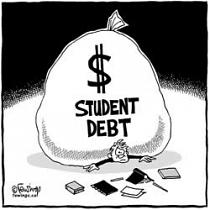Monetary Reform of the Bank of Canada would solve student debt crisis and redress other issues
Sixty per cent of university and college students graduate with debt. The average for university graduates in 2006 was $24,000, and estimated to be $15,600 for college students. One student wrote that after 22 months of loan re-payments at $389 a month ($8,558 in total) her loan balance had been reduced by only $780.51. This person, a single mother, trained to be a librarian so that she could support her daughter, but now she is in a debt trap and "cannot see an end in sight" - and she does not qualify for interest relief because she earns $100 a month more than the gross income allowed.
In 2004 there were 168,700 university graduates and 152,600 from college. The total debt of university graduates in 2006 amounted to $2.4-billion and for college graduates $1.3-billion for a total of $3.7-billion. At the same time that students were racking up this huge debt, Canadian taxpayers were spending $63-billion in interest on public debt - enough money to cover the cost of student debt, eliminate tuition fees altogether and provide additional funding for health care, housing and infrastructure if it were not spent on interest.
These huge interest payments have resulted in large part from a change in Bank of Canada ideology in 1974 at which time the free-market ideas of Milton Friedman and the Chicago School of Economics were adopted in Canada and in many other countries. These ideas promote the view that it is good to borrow from the private sector while reducing the government's use of the Bank of Canada to carry public debt. Unfortunately, however, this practice resulted in an unnecessary increase in the federal debt of over 3000%, from $18-billion in 1974 to $588-billion in 1997, with a corresponding increase in provincial and municipal debt.
Government response to using the Bank of Canada to finance public debt has been that it would cause inflation -- a position that completely ignores our history. From 1939 to 1974, the government used the Bank to finance a significant portion of public debt. In 1950 the inflation rate was 2.8 and, although it went up and down, in 1971 it was only 2.9. Then it began to rise, partly as a result of the big increase in the cost of oil. Traditionally, one of the tools used to contain inflation was the requirement for statutory reserves. These were removed by Prime Minister Brian Mulroney and would have to be re-instated to keep inflation under control if Bank of Canada financing were increased significantly, as it should be.
We suspect the reluctance to use the Bank to finance public debt is also based on the fear that if Canada's monetary policy should differ substantially from the “free-market” ideology, world financial interests would come down hard on Canada. The fear of repercussions is like a straight-jacket limiting the actions of politicians.
To get out of this straight-jacket mentality we need politicians who recognize the benefit of using the Bank of Canada -- politicians who recognize that through the Bank, and with Canada’s natural resources and well-educated work force, we could finance education, health services, infrastructure renewal and other community capital needs. The employment created from such activity would stimulate the private sector.
Because the reluctance of currently elected politicians to advocate use of the Bank to carry public debt is creating a burden on students (as well as the rest of us), we have decided to direct our attention to university and college students. We are focusing on the debt that 60 percent of them have to carry when they graduate ($3.7-billion every graduating year), how the misuse of the Bank of Canada is contributing to their debt and the changes that are needed.
We are asking the leaders of all the parties which have seats in the House plus the Green Party, the Canadian Action Party and other political parties who wish to participate, specific questions related to this issue. Their answers will be published on line and elsewhere for students and anyone else who is interested.
We hope students will see that they can help themselves and help to change the way the Bank of Canada is used by voting for politicians who are committed to using the Bank of Canada to carry public debt. To see our message to the students, review the website Bankslovedebt.com.
Make comments about this article in The Canadian Blog.
About the writer:
Richard Priestman a representative of the Kingston Chapter of the Committee on Monetary and Economic Reform. E-mail: LINK
Other signatories:
Kevin Connolly, Hugh and Claire Jenney, Dolores Priestman, Don Rogers, Peter Zuuring, Frank Zuuring, Darko Matovic, George Miklos Biro, Bill and Nora Parish, Bill Fisher, Rose DeShaw, Michelle Dorey, Garth Rutherford, Martha McDermott, Henry A. Becker, Morris L. Wood, Lars Henry Thompson, Peter Mautner.
Comments
There are 1 comments on this post
- Date: 28 July 2011
- Posted By :















